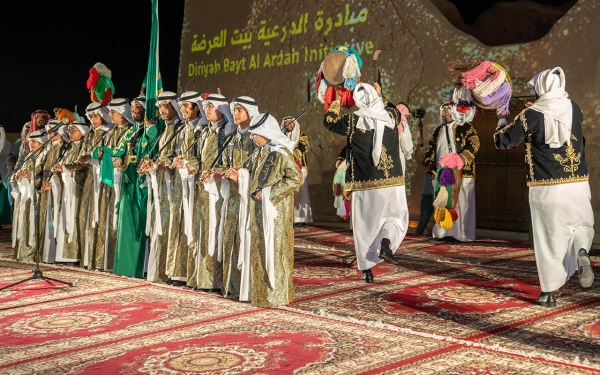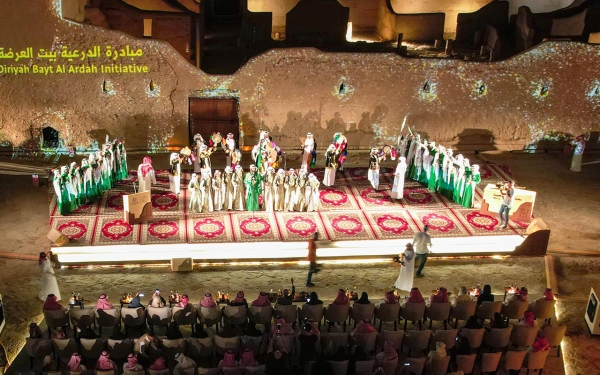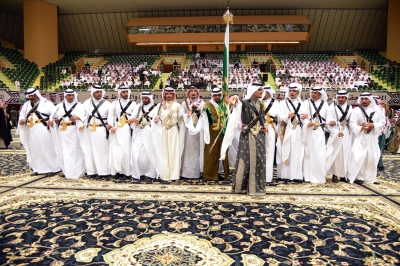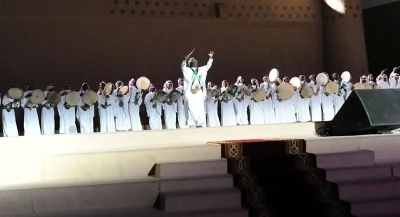

Drums in Saudi Ardah are percussion instruments used in Saudi Ardah. The drums are made of camel skin, laminated from both sides, and their frame is clad with a piece of fabric. The chorus (vocal) aspect of the Saudi Ardah predominates over the instrumental aspect because it did not need introducing melodic instruments such as al-Rababah or al-Semsemiya, due to the limited scope for euphony, since it is a war dance.
Drums selection in Saudi Ardah
The selection of instruments accompanying the Saudi Ardah is based on three factors:
- The first is a biopsychosocial basis, as in ancient times, warriors needed chants, melodies, and rhythms to strengthen their resolve and intimidate their enemies. These are accompanied by thunderous sounds to increase enthusiasm. Hence, the two types of drums were introduced.
- The second is an environmental basis, and has an impact on the types of instruments and materials used in making them, whether they are animal-derived materials 'like camel skin, horsetail hair, and sheep wool', or plant-derived materials like palm tree trunks and bamboo sticks.
- The third is human creativity, which drove folk artists to decorate folk instruments. They drew on leather parchment and adorned al-tathlith drums with hanging colorful woolen tapestries known as 'al-Raith' or ‘al-Danadeesh’ or ‘al-Kathal'.
Drums used in Saudi Ardah
The instruments used in the Saudi Ardah are drums of two types: large drums which are called 'al-takhmir drums' and small drums which are called 'al-tathlith drums' . The frame of the large drum is made of palm trunks, called 'al-barhi' with a thickness of about two to four cm, and with a circular diameter of about seventy-five cm, and is about fifteen cm wide. As the drum size increases, its sound becomes more powerful. Al-tathlith drum is the smaller. Since al-takhmir drums are bigger than al-tathlith drums, they provide the rhythm with light tones and serve as the basic unit in its 'pulse'.
Drums tuning in the Saudi Ardah
Drumming does not adhere to specific musical notes in the Saudi Ardah, such as setting al-takhmir drums with the first tone in al-maqam and al-tathlith in the fifth tone. Saudi folk artists were only focused on tuning al-tathlith to a sharp tone and al-takhmir to a dense tone, using primitive sound-tuning methods, such as exposing the instrument to sunlight in the summer, or heating leather parchments in winter.
How Saudi Ardah drums work
Al-takhmir drums are hung around the drumbeater’s shoulder using a leather strap while he holds the handle with his left hand, and beats the drum with a thick stick held by his right hand. The drumstick is made of bamboo, approximately thirty cm long, and curved at its far end. The drum is struck from the curved end with the drum tilted slightly to the left, while the drumbeater moves his body in both right and left directions, then switches direction, raising the opposite-direction foot and slightly bending his knees down. The number of al-takhmir drumbeaters is between six and eight. The larger their number, the louder and more spectacular al-Ardah becomes, as the presence of more drumbeaters helps stir up the enthusiasm of performers and their impact.
Al-tathlith drumbeaters perform dancing movements while drumming, lifting their left hand, which is holding the drum, and then lowering it downward and forward, while consecutively jumping twice, then squatting and standing again. Small drums used are lightweight for ease of control. A piece of cloth is wrapped around the handle in order not to hurt the drumbeater’s hand. The drum frame is decorated with some tapestries similar to large drums, colloquially called 'al-Raith' or ‘al-Danadeesh’ because they are ornated with lots of decorative and aesthetic motifs, which are visually pleasing when the drums are moved.
Related quizzes
Related articles


